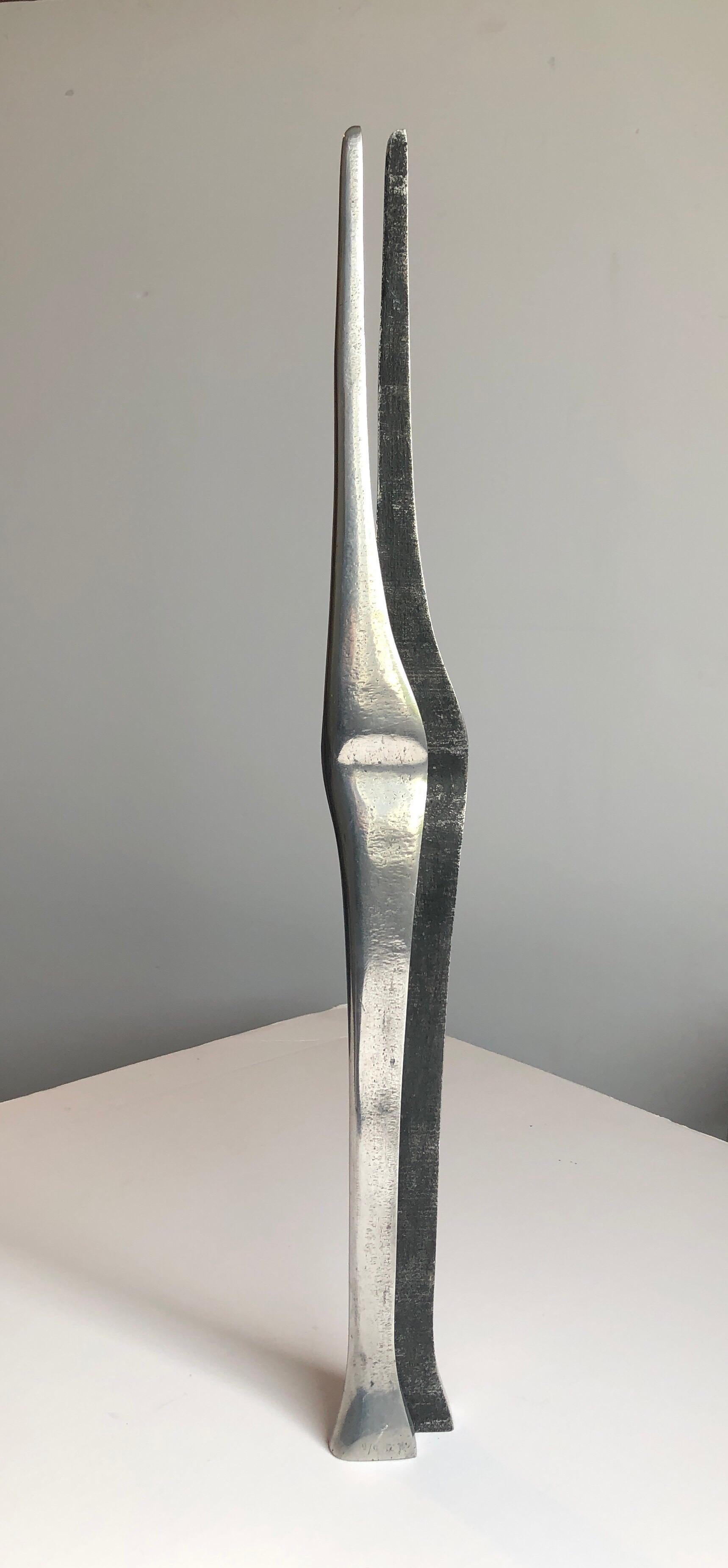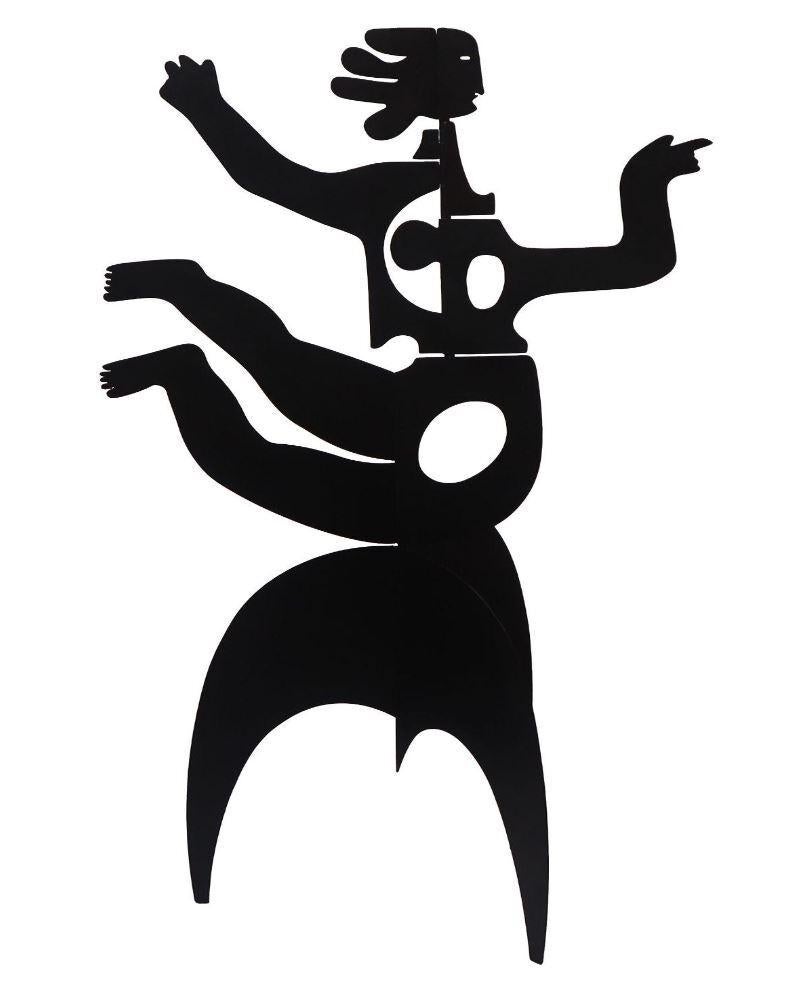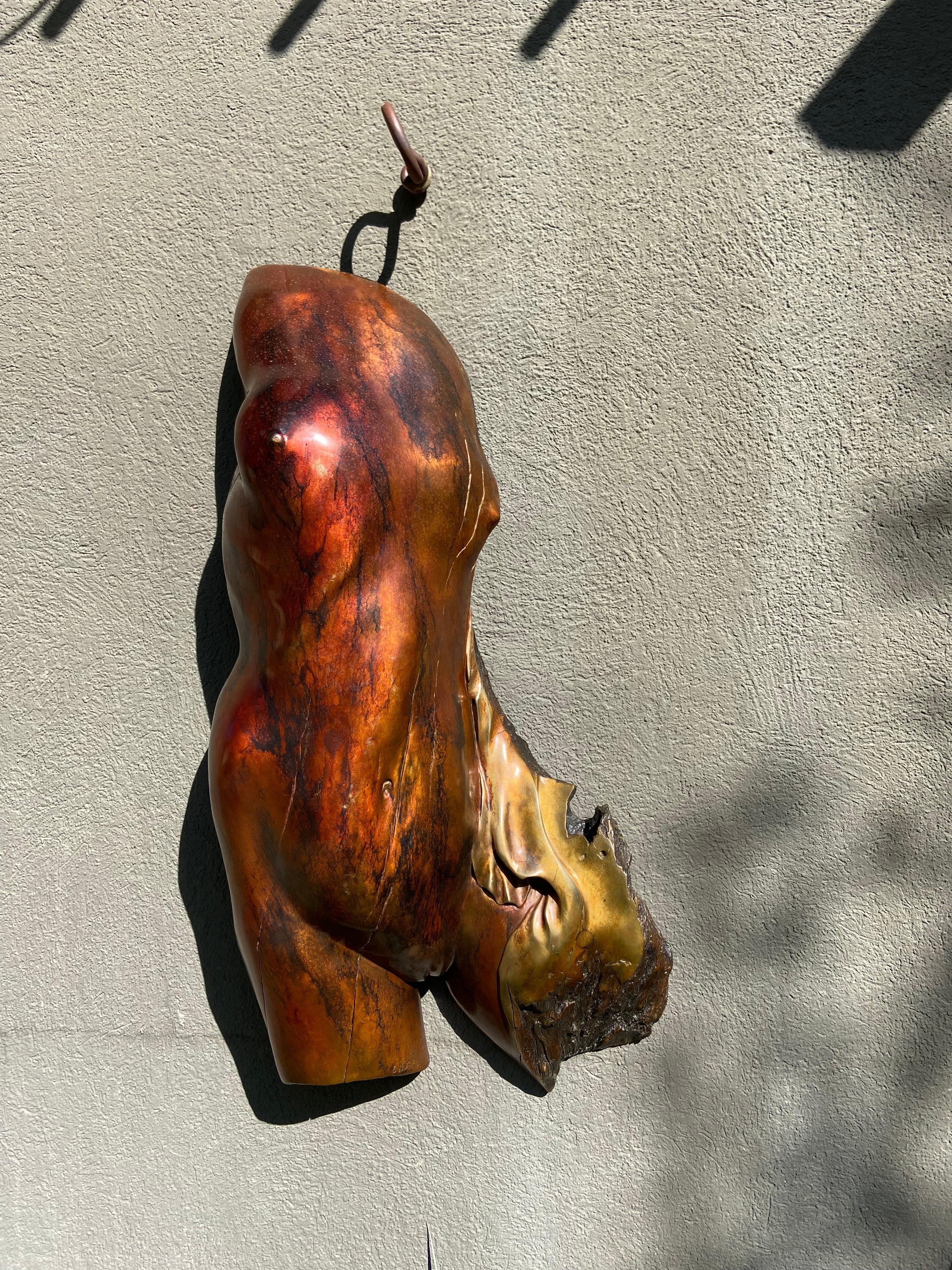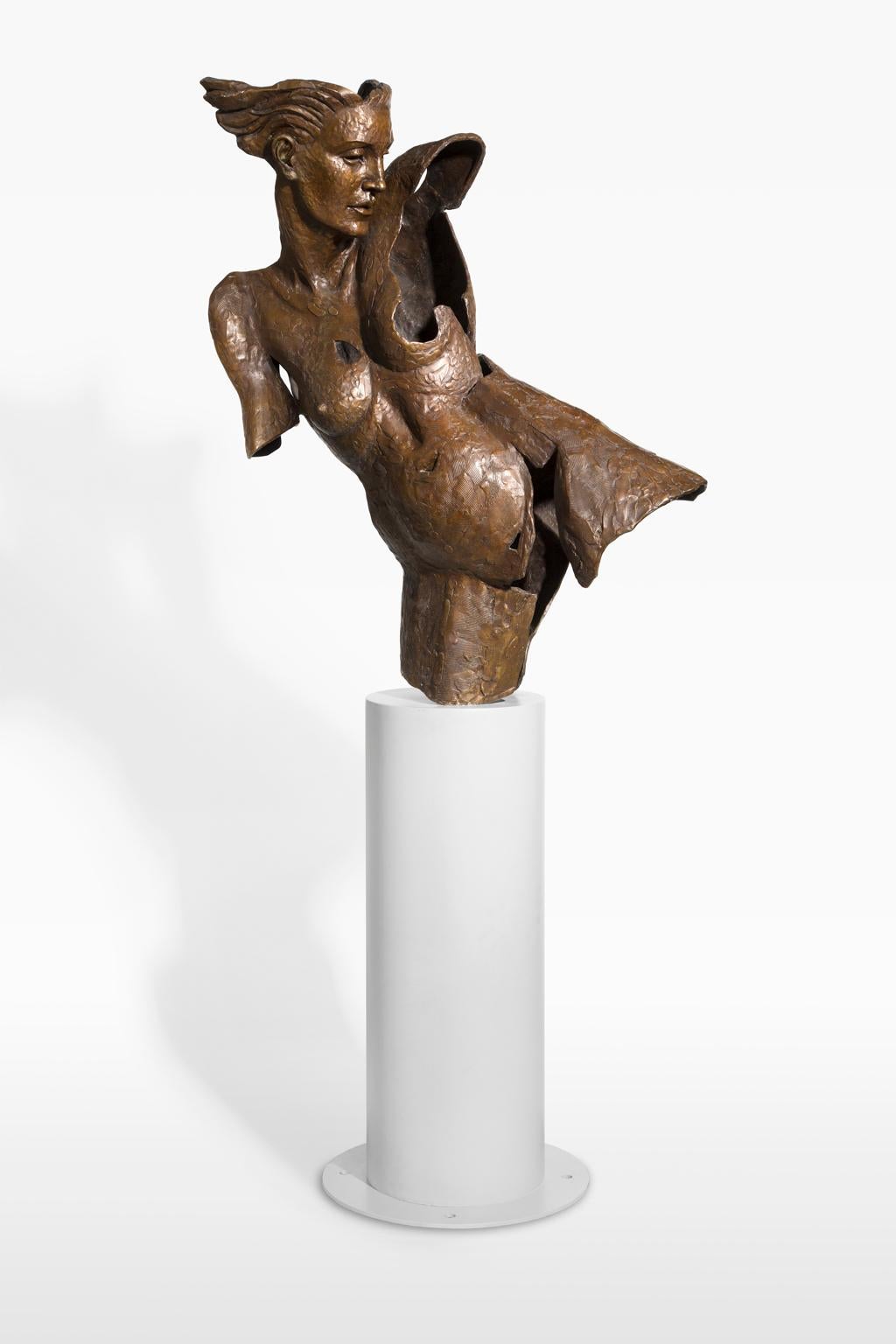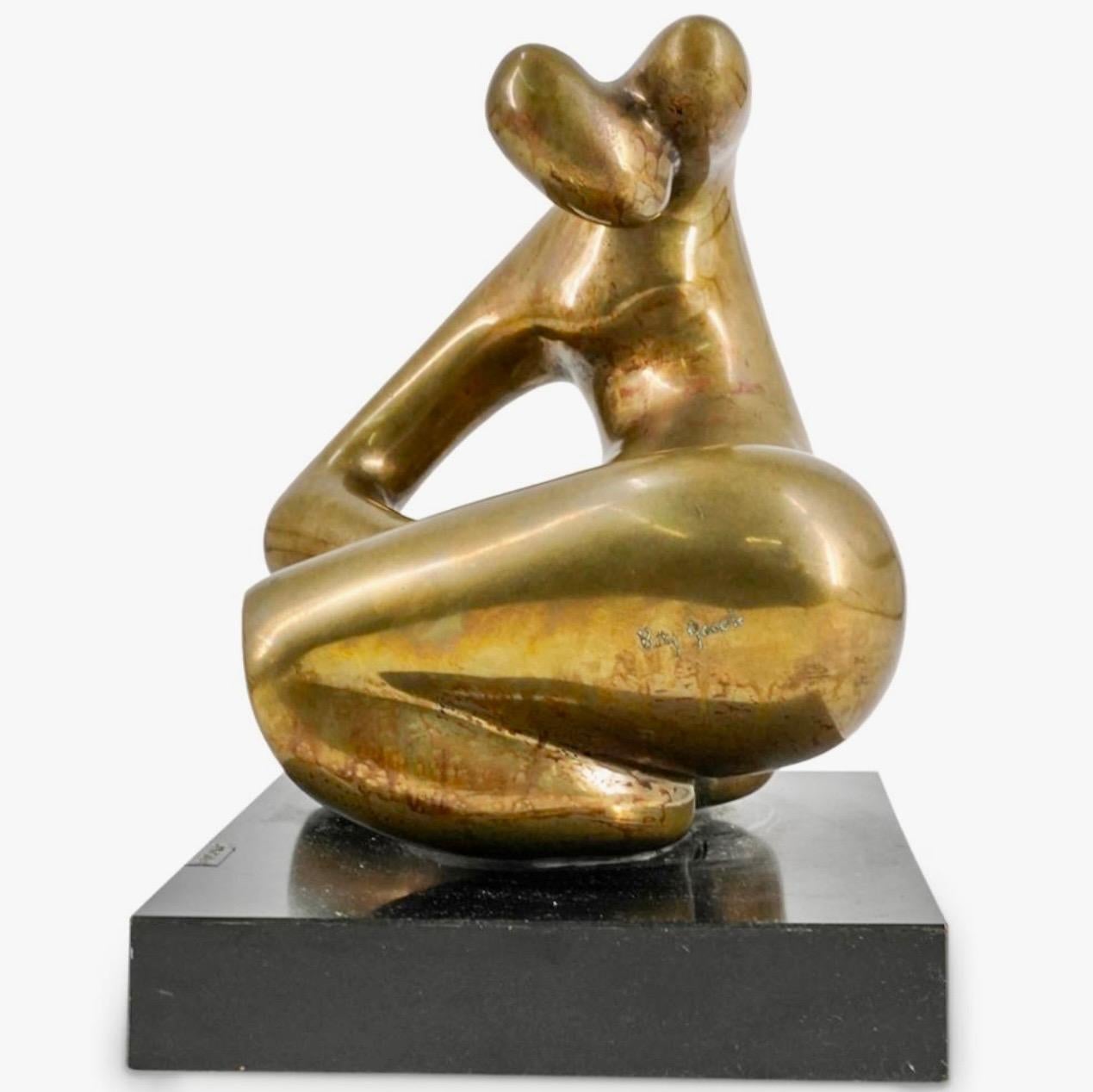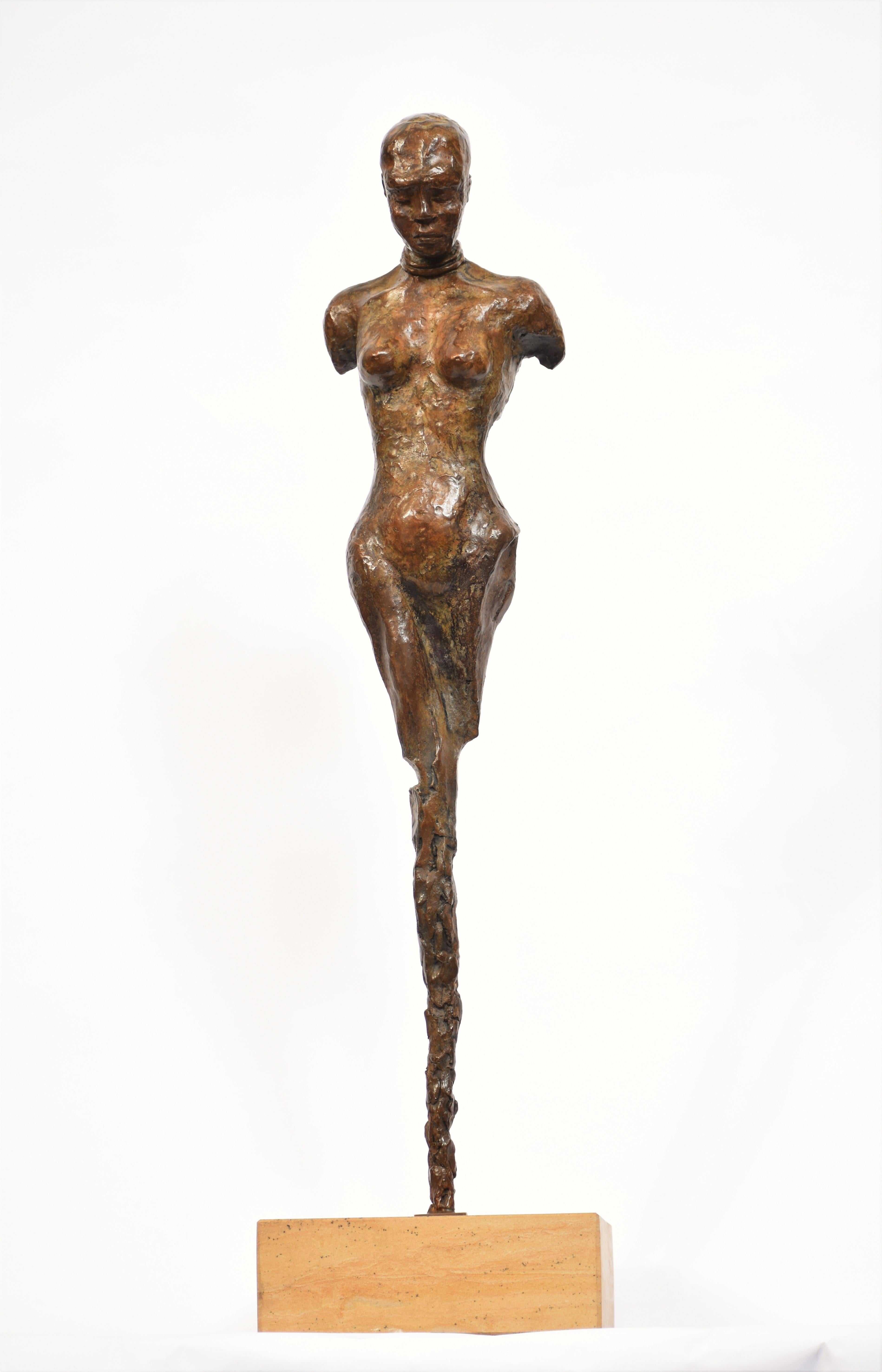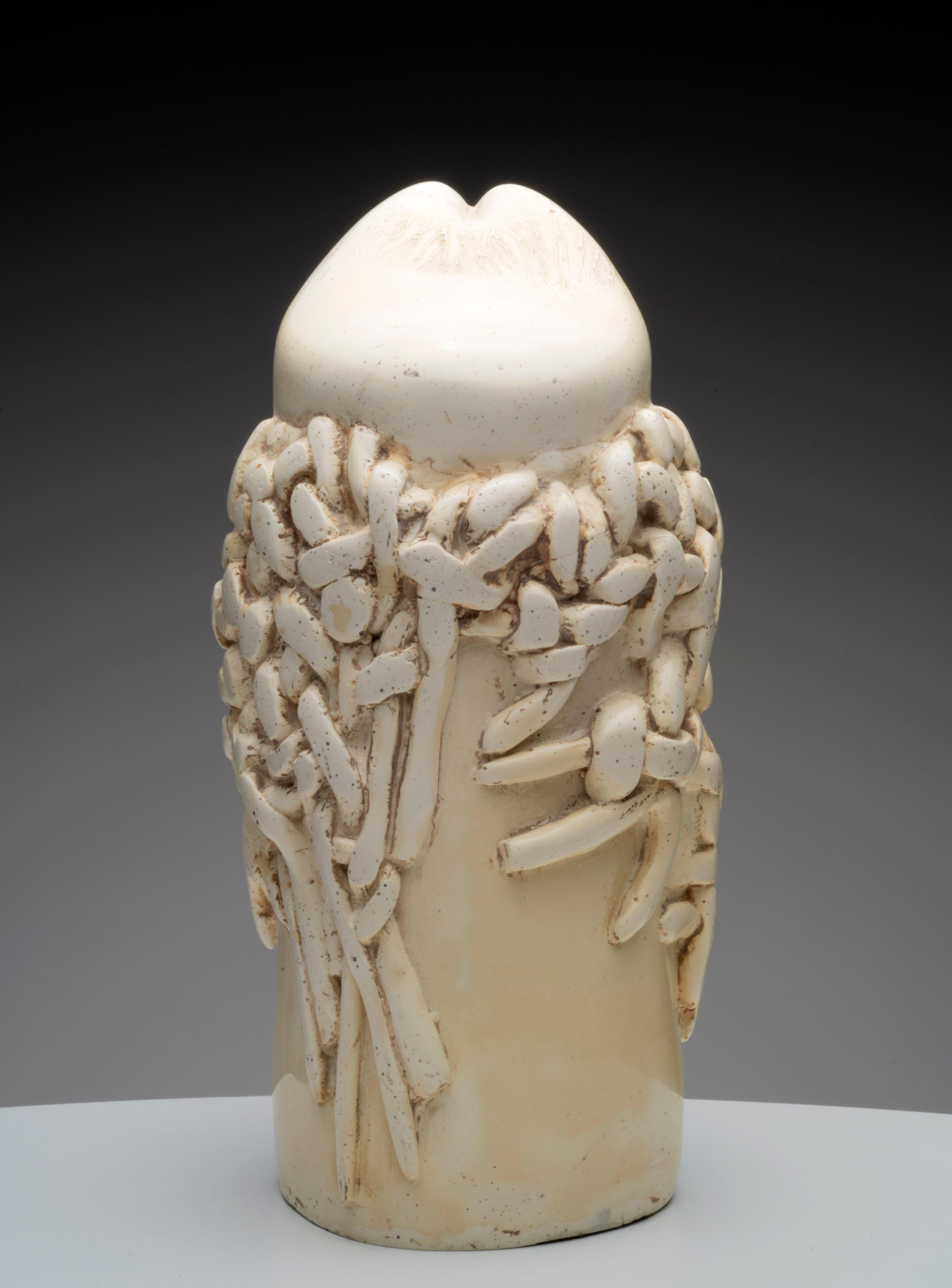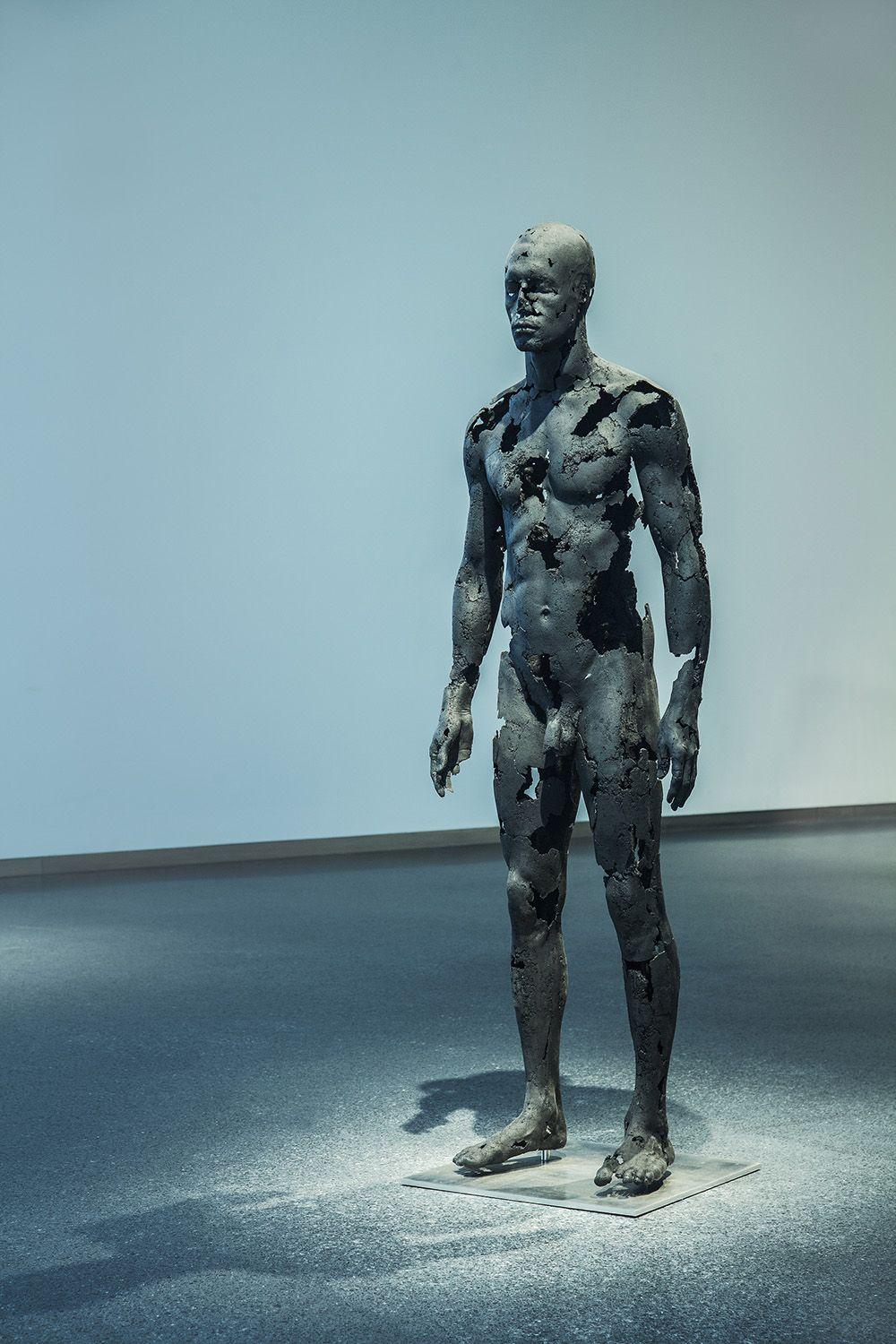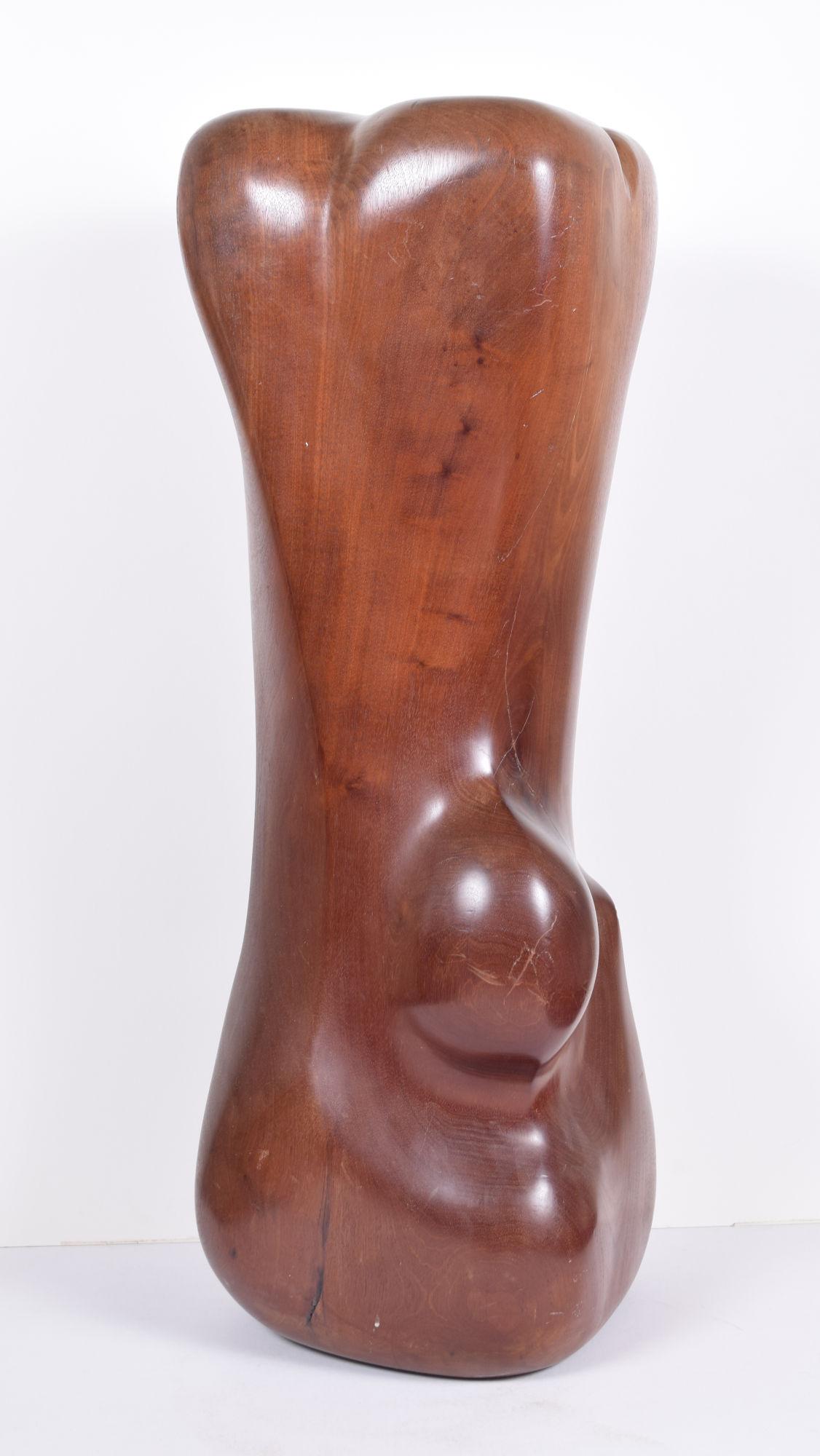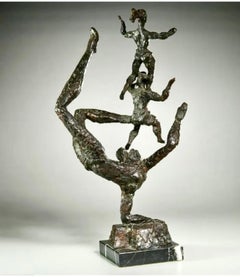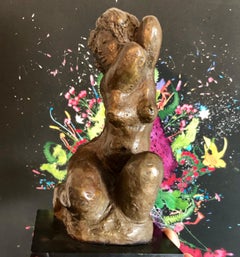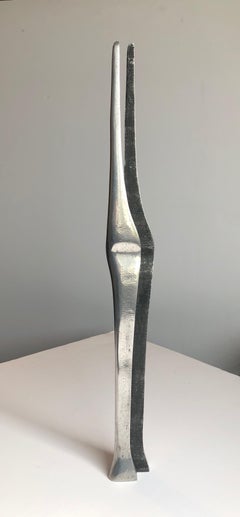
Aharon Bezalel Israeli Modernist Sculpture 2 Parts Minimalist Aluminum or Steel
View Similar Items
Want more images or videos?
Request additional images or videos from the seller
1 of 15
Aharon BezalelAharon Bezalel Israeli Modernist Sculpture 2 Parts Minimalist Aluminum or Steel 1979
1979
About the Item
- Creator:Aharon Bezalel (1925-2012, Afghan)
- Creation Year:1979
- Dimensions:Height: 25.5 in (64.77 cm)Width: 2.5 in (6.35 cm)Depth: 2 in (5.08 cm)
- Medium:
- Movement & Style:
- Period:
- Condition:fine patina, mild surface wear.
- Gallery Location:Surfside, FL
- Reference Number:Seller: 13991stDibs: LU3824445441
About the Seller
4.9
Platinum Seller
These expertly vetted sellers are 1stDibs' most experienced sellers and are rated highest by our customers.
Established in 1995
1stDibs seller since 2014
1,541 sales on 1stDibs
Typical response time: 1 hour
More From This SellerView All
- Aharon Bezalel Israeli Modernist Sculpture 2 Parts Minimalist Aluminum or SteelBy Aharon BezalelLocated in Surfside, FLA suite of 2 sculptures. Lovers, man and woman nestled together. sleek minimalist mod sculpture. polished finish on one side. not sure if theese are stell or aluminium. they are cast...Category
1970s Minimalist Abstract Sculptures
MaterialsMetal
- Large Chaim Gross Mid Century Mod Bronze Sculpture Circus Acrobats WPA ArtistBy Chaim GrossLocated in Surfside, FLChaim Gross (American, 1904-1991) Patinated cast bronze sculpture, Three Acrobats, signed mounted on black marble plinth 24.5"h x 14"w x 7"d (bronze alone) Chaim Gross (March 17, 1904 – May 5, 1991) was an American modernist sculptor and educator. Gross was born to a Jewish family in Austrian Galicia, in the village of Wolowa (now known as Mezhgorye, Ukraine), in the Carpathian Mountains. In 1911, his family moved to Kolomyia (which was annexed into the Ukrainian USSR in 1939 and became part of newly independent Ukraine in 1991). When World War I ended, Gross and brother Avrom-Leib went to Budapest to join their older siblings Sarah and Pinkas. Gross applied to and was accepted by the art academy in Budapest and studied under the painter Béla Uitz, though within a year a new regime under Miklos Horthy took over and attempted to expel all Jews and foreigners from the country. After being deported from Hungary, Gross began art studies at the Kunstgewerbeschule in Vienna, Austria shortly before immigrating to the United States in 1921. Gross's studies continued in the United States at the Beaux-Arts Institute of Design, where he studied with Elie Nadelman and others, and at the Art Students League of New York, with Robert Laurent. He also attended the Educational Alliance Art School, studying under Abbo Ostrowsky, at the same time as Moses Soyer and Peter Blume. In 1926 Gross began teaching at The Educational Alliance, and continued teaching there for the next 50 years. Louise Nevelson was among his students at the Alliance (in 1934), during the time she was transitioning from painting to sculpture. In the late 1920s and early 1930s he exhibited at the Salons of America exhibitions at the Anderson Galleries and, beginning in 1928, at the Whitney Studio Club. In 1929, Gross experimented with printmaking, and created an important group of 15 linocuts and lithographs of landscapes, New York City streets and parks, women in interiors, the circus, and vaudeville. The entire suite is now in the collection of the Philadelphia Museum of Art. Gross returned to the medium of printmaking in the 1960s, and produced approximately 200 works in the medium over the next two decades. For more than sixty years Chaim Gross's art has expressed optimistic, affirming themes, Judaica, balancing acrobats, cyclists, trapeze artists and mothers and children convey joyfulness, modernism, exuberance, love, and intimacy. This aspect of his work remained consistent with his Jewish Hasidic heritage, which teaches that only in his childlike happiness is man nearest to God. In March 1932 Gross had his first solo exhibition at Gallery 144 in New York City. For a short time they represented Gross, as well as his friends Milton Avery, Moses Soyer, Ahron Ben-Shmuel and others. Gross was primarily a practitioner of the direct carving method, with the majority of his work being carved from wood. Other direct carvers in early 20th-century American art include William Zorach, Jose de Creeft, and Robert Laurent. Works by Chaim Gross can be found in major museums and private collections throughout the United States, with substantial holdings (27 sculptures) at the Hirshhorn Museum and Sculpture Garden. A key work from this era, now at the Smithsonian American Art Museum, is the 1932 birds-eye maple Acrobatic Performers, which is also only one and one quarter inch thick. In 1933 Gross joined the government's PWAP (Public Works of Art Project), which transitioned into the WPA (Works Progress Administration), which Gross worked for later in the 1930s. Under these programs Gross taught and demonstrated art, made sculptures that were placed in schools and public colleges, made work for Federal buildings including the Federal Trade Commission Building, and for the France Overseas and Finnish Buildings at the 1939 New York World's Fair. Gross was also recognized during these years with a silver medal at the Exposition universelle de 1937 in Paris, and in 1942, with a purchase prize at the Metropolitan Museum of Art's "Artists for Victory" exhibition for his wood sculpture of famed circus performer Lillian Leitzel. In 1949 Gross sketched Chaim Weizmann, President of Israel, at several functions in New York City where Weizmann was speaking, Gross completed the bust in bronze later that year. Gross returned to Israel for three months in 1951 (the second of many trips there in the postwar years) to paint a series of 40 watercolors of life in various cities. This series was exhibited at the Jewish Museum (Manhattan) in 1953. In the 1950s Gross began to make more bronze sculptures alongside his wood and stone pieces, and in 1957 and 1959 he traveled to Rome to work with famed bronze foundries including the Nicci foundry. At the end of the decade Gross was working primarily in bronze which allowed him to create open forms, large-scale works and of course, multiple casts. Gross's large-scale bronze The Family, donated to New York City in 1991 in honor of Mayor Ed Koch, and installed at the Bleecker Street Park at 11th street, is now a fixture of Greenwich Village. In 1959, a survey of Gross's sculpture in wood, stone, and bronze was featured in the exhibit Four American Expressionists curated by Lloyd Goodrich at the Whitney Museum of American Art, with work by Abraham Rattner, Doris Caesar, and Karl Knaths. In 1976, a selection from Gross's important collection of historic African sculpture, formed since the late 1930s, was exhibited at the Worcester Art Museum in the show The Sculptor's Eye: The African Art Collection of Mr. and Mrs. Chaim Gross. Gross was elected into the National Academy of Design as an Associate member, and became a full Academician in 1981. In 1984, he was inducted into the American Academy of Arts and Letters, with Jacob Lawrence and Lukas Foss. In the fall of 1991, Allen Ginsberg gave an important tribute to Gross at the American Academy of Arts and Letters, which is published in their Proceedings. In 1994, Forum Gallery, which now represents the Chaim Gross estate, held a memorial exhibition featuring a sixty-year survey of Gross's work. Gross was a professor of printmaking and sculpture at both the Educational Alliance and the New School for Social Research in New York City, as well as at the Brooklyn Museum Art School, the MoMA art school, the Art Student's League and the New Art School (which Gross ran briefly with Alexander Dobkin...Category
Mid-20th Century American Modern Figurative Sculptures
MaterialsMarble, Bronze
- Bronze Female Nude Sculpture Modernist, WPA, New York Chelsea Hotel ArtistBy Eugenie GershoyLocated in Surfside, FLEugenie Gershoy (January 1, 1901 – May 8, 1986) was an American sculptor and watercolorist. Eugenie Gershoy was born in Krivoy Rog, Russia (Krivoi Rog, Ukraine) and emigrated to New York City in the United States as a child in 1903. Considered somewhat of a child prodigy, Gershoy was copying Old Master drawings at the age of 5. Her interest and talent in art was encouraged from a very young age. Aided by scholarships, she studied at the Art Students League under Alexander Stirling Calder, Leo Lentelli, Kenneth Hayes Miller, and Boardman Robinson. Around this time, she created a group of portrait figurines of her fellow artists, including Arnold Blanch, Lucile Blanch, Raphael Soyer, William Zorach, Concetta Scaravaglione, and Emil Ganso, which were exhibited as a group at the Whitney Museum of American Art. At age 17, she was awarded the Saint-Gaudens Medal for fine draughtsmanship. Early in her career she became an active member of the Woodstock art colony. In Woodstock she experimented by sculpting in the profusion of indigenous materials that she found. Working with fieldstone, oak and chestnut, Gershoy created works based on classic formulae. As she became more interested in the dynamism of everyday life, she found that these materials and her idiom were too restrictive. By the time Gershoy came to Woodstock in 1921 her own individual artistic style was already evident in her sculptures. Eugenie Gershoy worked in stone, bronze, terracotta, plaster and papier-mache. Gershoy’s sculptures were mainly figurative in nature and many of her artist peers such as Carl Walters, Raphael and Moses Soyer, William Zorach and Lucille Blanch, became her subjects. Eugenie Gershoy’s works on paper should not be overlooked. She was the winner of the Gaudens Medal for Fine Draughtsmanship at the tender age of 17. Gershoy married Jewish Romanian-born artist Harry Gottlieb. In the late 1920s and early 1930s, the pair kept a studio in Woodstock, New York. There, Gershoy was influenced by sculptor John Flanagan, who lived and worked nearby. From 1936 to 1939, Gershoy worked for the WPA Federal Art Project. She collaborated with Max Spivak on murals for the children's recreation room of the Queens Borough Public Library in Astoria, New York. She developed a mixture of wheat paste, plaster, and egg tempera, which she used in polychrome papier-mâché sculptures; she was the only New York sculptor to work in polychrome at this time. She also designed cement and mosaic sculptures of animals and figures to be placed in New York City playgrounds. Alongside others employed by the FAP, she participated in a sit-down strike in Washington, DC, to advocate for better pay and improved working conditions for the projects' artists. Gershoy's first solo exhibition was held at the Robinson Gallery in New York in 1940. She moved to San Francisco in 1942, and began teaching ceramics at the California School of Fine Arts in 1946. In 1950, she studied at the artists' colony at Yaddo. Gershoy traveled extensively throughout her life. She visited England and France in the early 1930s, and worked in Paris in 1951. She traveled to Mexico and Guatemala in the late 1940s, and also toured Africa, India, and the Orient in 1955. In 1977, Gershoy dedicated a sculpture to Audrey McMahon, who was actively involved in the creation of the Federal Art Project and served as its regional director in New York, in recognition of the work McMahon provided struggling artists in the 1930s. Gershoy's work is in the collections of the Whitney Museum of American Art, the Metropolitan Museum of Art, and the Smithsonian American Art Museum. Her papers are held at Syracuse University Grant Arnold introduced her to lithography in 1930 and Gershoy depicted many scenes of Woodstock artists and their daily activities through this medium. From 1942 to 1966 Gershoy lived and painted in San Francisco where she taught at the San Francisco Art Institute. She traveled extensively, filling sketchbooks with scenes of Mexico, France, Spain, Africa and India. During her later years Eugenie Gershoy returned to New York City and concentrated on numerous well received exhibitions. Her last exhibition in at Sid Deutsch Gallery included many of the sculptures that were later exhibited in the Fletcher Gallery. John Russell, former chief critic of fine arts for the New York Times, writes about the 1986 Sid Deutsch exhibition: “As Eugenie Gershoy won the Saint-Gaudens Medal for fine draftsmanship as long ago as 1914 and since 1967 has had 15 papier-mache portrait figures suspended from the ceiling of the lobby of the Hotel Chelsea, she must be ranked as a veteran of the New York scene. Her present exhibition includes not only the high-spirited papier-mache sculptures for which she is best known but a group of small portraits of artists, mostly dating from the 30’s, that is strongly evocative.” Eugenie Gershoy is an artist to take note of for several reasons. She was a woman who received great awards and recognition during a time when most female artists were struggling to hold their own against their male counterparts. As a young girl she won a scholarship to the Arts Student League where she met Hannah Small...Category
Mid-20th Century American Modern Nude Sculptures
MaterialsBronze
- Large Latin American Mexican Master Bronze Sculpture Mother with Child SIgnedBy Felipe CastañedaLocated in Surfside, FLFrom small limited edition of 7, this is a signed and dated hollow cast bronze sculpture. Provenance: Important Miami Beach estate that included many paintings and sculpture by Post Impressionist masterpieces and works by Latin American masters. Felipe Castaneda (Mexican, b.1933) was born in 1933 in La Palma in the state of Michoacan, Mexico. His artistic career began at the National Museum of Anthropology in Mexico City where he became an assistant to the renowned sculptor Francisco Zúñiga (French, 1867–1947), Zuniga helped the artist realize his aptitude for sculpting and carving. Castañeda finished his studies in 1963, and by 1970, he was showing his work in exhibitions. Castañeda experimented with many media in order to master molding clay for his sculptures, preferring to work in marble, onyx, and bronze. The heavy influence of pre-Columbian artifacts is evident in his traditional approach to representing the human form. His stylized depictions of the female body are just one example of his expressive use of the media he works with. His sculptures have appeared in exhibitions all over the world, including commissioned public sculptures in Mexico and California. His works are part of the permanent collections of the Los Angeles County Museum of Art and the Museum of Art History in Ciudad Juarez, Mexico. Select Exhibitions 2002 “Images of Latin America,” with Vladimir Cora...Category
1980s Figurative Sculptures
MaterialsBronze
- Large Modernist Bronze Abstract Figural Sculpture "Family" Wolfgang BehlLocated in Surfside, FLThis is a mid 20th century mod abstract large bronze sculpture by Wolfgang Behl (German/American, 1918-1994). The sculptural group titled "The Family" features a mother and father with two children. Numbered 20/20. Signed. 21" H x 10 1/4" x 10 1/4 Wolfgang (Johann Wolfgang) Behl (1918 - 1994) was active/lived in Connecticut, Illinois / Germany. Known for Sculpture and as an architectural carver. A carver,designer, and teacher, Wolfgang Behl was born in Berlin, Germany where he studied at the Berlin Academy of Fine Arts. His teacher was otto Hitzberger, sculptor and architecture carver. I have seen some his work, particularly in carved wood compared to Constantin Brancusi although this one seems way more reminiscent of Alberto Giacometti. In 1939, Behl came to the United States and taught briefly in Pennsylvania at the Perkiomen School and in Rhode Island at the Rhode Island School of Design. There in 1943, he won the Joseph N. Eisendrath prize for sculpture. He also became a friend of Louis Mayer...Category
20th Century Expressionist Figurative Sculptures
MaterialsMarble, Bronze
- Sydney Kumalo Bronze Minimalist African Modernist Sculpture Figural Female NudeLocated in Surfside, FLSydney Kumalo. Features a bronze stylized female figural form sculpture fixed to a marble plinth and wood base. Bears signature on base. Measures 9 1/2...Category
20th Century Modern Figurative Sculptures
MaterialsMarble, Bronze
You May Also Like
- EvaLocated in New York, USAntonine de Saint Pierre, born in the Paris region in 1974, stands as a beacon in the contemporary art world, intertwining the nostalgic allure of the 1950s and 60s with a modern, in...Category
2010s Contemporary Nude Sculptures
MaterialsSteel, Metal
- Daphne, 40" high bronze reliefLocated in Loveland, CODaphne by Leo E. Osborne High Relief Female Torso, originally carved from Maple Burl. Patina merges from red to gold. Bronze 40x17x9" ed/50 The sculpture retains some of the natura...Category
Early 2000s Contemporary Nude Sculptures
MaterialsBronze
- "Resonance" Bronze Female Nude Sculpture with Powder Coated Steel BaseLocated in Detroit, MI“Resonance” references Greek classical sculpture and modernist traditions. The female from is depicted as a fragment, introspective and animated. The surface of the sculpture is rich...Category
Early 2000s Contemporary Nude Sculptures
MaterialsBronze, Steel
- Modern Bronze FigureLocated in New York, NYBronze sculpture by Betty Jacob depicts a smooth and curvaceous gilt bronze figure posing on her knees. Signed high on the left thigh and mounted on a blac...Category
1970s American Modern Nude Sculptures
MaterialsBronze
$3,200 Sale Price20% Off - Dominique Polies Nude Bronze SculptureLocated in Delray Beach, FLNude Bronze Sculpture. Dominique Polles' bronze sculptures of female nude edition 2/4 patinated bronze signed and dated 1999. Born in Paris in 1945, young ...Category
1990s Cubist Abstract Sculptures
MaterialsBronze
- Young Woman - Bronze Abstract Nude - Limited EditionLocated in Pretoria, ZAYoung Woman in bronze, abstract nude figurative bronze sculpture, limited edition of 24, height 64 cm including base, Sandstone base: approx 17 cm x 15 cm x 5 cm. Cast bronze using t...Category
2010s Expressionist Nude Sculptures
MaterialsSandstone, Bronze
Recently Viewed
View AllMore Ways To Browse
Modernist Aluminum
Head Metal Sculpture
Lovers Sculpture
Male And Female Sculptures
Abstract Female Sculpture
Sculptures Of Lovers
Man Of Parts
Man Head Sculpture
Casted Aluminium Sculpture
Cast Aluminum Sculpture
Ancient Head Sculpture
Aluminum Sphere
Minimalist Metal Sculpture
Minimalist Metal Sculptures
Vintage Steel Chest
Sculpture Woman Metal
Metal Modernist Sculpture
Minimalist Steel Sculptures
